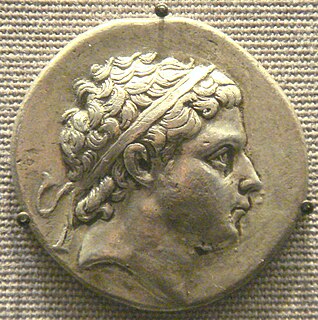Related Research Articles
Year 149 BC was a year of the pre-Julian Roman calendar. At the time it was known as the Year of the Consulship of Censorinus and Manilius. The denomination 149 BC for this year has been used since the early medieval period, when the Anno Domini calendar era became the prevalent method in Europe for naming years.
This article concerns the period 189 BC – 180 BC.
Year 150 BC was a year of the pre-Julian Roman calendar. At the time it was known as the Year of the Consulship of Flamininus and Balbus. The denomination 150 BC for this year has been used since the early medieval period, when the Anno Domini calendar era became the prevalent method in Europe for naming years.
Year 188 BC was a year of the pre-Julian Roman calendar. At the time it was known as the Year of the Consulship of Messalla and Salinator. The denomination 188 BC for this year has been used since the early medieval period, when the Anno Domini calendar era became the prevalent method in Europe for naming years.
Year 186 BC was a year of the pre-Julian Roman calendar. At the time it was known as the Year of the Consulship of Albinus and Philippus. The denomination 186 BC for this year has been used since the early medieval period, when the Anno Domini calendar era became the prevalent method in Europe for naming years.
Year 154 BC was a year of the pre-Julian Roman calendar. At the time it was known as the Year of the Consulship of Opimius and Albinus/Glabrio. The denomination 154 BC for this year has been used since the early medieval period, when the Anno Domini calendar era became the prevalent method in Europe for naming years.
Year 183 BC was a year of the pre-Julian Roman calendar. At the time it was known as the Year of the Consulship of Marcellus and Labeo. The denomination 183 BC for this year has been used since the early medieval period, when the Anno Domini calendar era became the prevalent method in Europe for naming years.
Year 243 BC was a year of the pre-Julian Roman calendar. At the time it was known as the Year of the Consulship of Fundulus and Galus. The denomination 243 BC for this year has been used since the early medieval period, when the Anno Domini calendar era became the prevalent method in Europe for naming years.

Bithynia was an ancient region, kingdom and Roman province in the northwest of Asia Minor, adjoining the Sea of Marmara, the Bosporus, and the Black Sea. It bordered Mysia to the southwest, Paphlagonia to the northeast along the Pontic coast, and Phrygia to the southeast towards the interior of Asia Minor.

Nicomedes I, second king of Bithynia, was the eldest son of Zipoetes I, whom he succeeded on the throne in 278 BC.

Prusias I Cholus was a king of Bithynia, who reigned from c. 228 to 182 BC.

Prusias II Cynegus was the Greek king of Bithynia. He was the son and successor of Prusias I and Apama III.
Ziaelas, third king of Bithynia, was a son of Nicomedes I and Ditizele.

Attalus II Philadelphus was a King of Pergamon and the founder of the city of Attalia (Antalya).

Bithynia and Pontus was the name of a province of the Roman Empire on the Black Sea coast of Anatolia. It was formed during the late Roman Republic by the amalgamation of the former kingdoms of Bithynia and Pontus. The amalgamation was part of a wider conquest of Anatolia and its reduction to Roman provinces.
Apame IV, sometimes known as Apama IV was a princess from the Antigonid dynasty. Her father was Philip V, King from 221 BC to 179 BC and her brother was Perseus, King from 179 BC to 167 BC. She was the wife of King Prusias II Cynegus of Bithynia, and mother of his successor, Nicomedes II Epiphanes. Her husband was her cousin because her aunt Apama III, was the wife of Prusias I Cholus.

The stele of Prusias is one of the ex votos at the sanctuary of Apollo in Delphi, constructed in honour of king Prusias II of Bithynia.

Bithynian coinage refers to coinage struck by the Kingdom of Bithynia that was situated on the coast of the Black Sea.

The Bosporan era, also called the Bithynian era, Pontic era or Bithyno-Pontic era, was a calendar era used from 149 BC at the latest until at least AD 497 in Asia Minor and the Black Sea region. It originated in the Bithynian Kingdom and was also used in the Pontic Kingdom and, for the longest time, in the Bosporan Kingdom. The calendar era begins with the assumption of the royal title by Zipoetes I of Bithynia in October 297 BC, which marks the start of its year one. The Bosporan year began at the autumnal equinox.